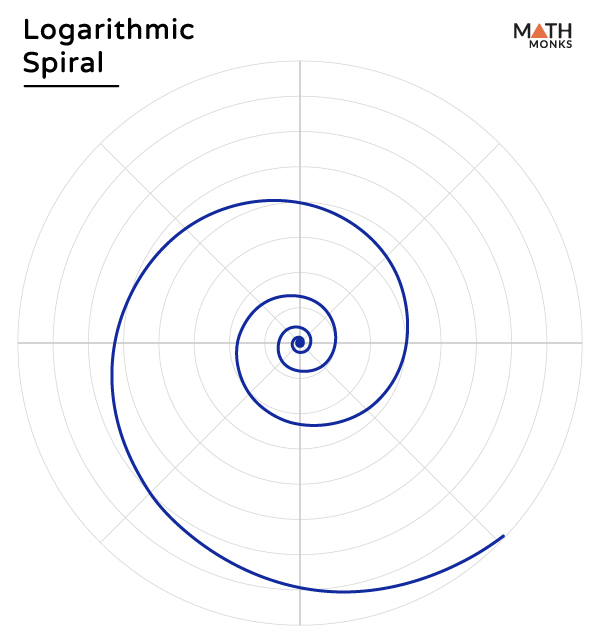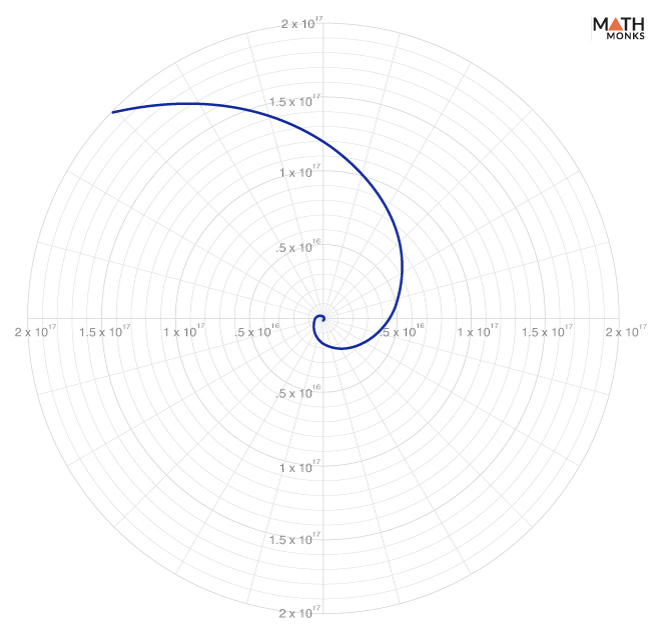A logarithmic spiral, also called an equiangular spiral or growth spiral, is a special type of curve found in nature, such as spider webs, shells of some mollusks, and the fossils of ammonites. It cuts all radial lines at a constant angle θ.
Descartes first described it, which was later explained by Jakob Bernoulli.
The logarithmic spiral relates to the golden rectangle, the golden ratio, and the fibonacci spiral, and thus, sometimes, it is referred to as the golden spiral.
Equations
Polar Form
In polar coordinates (r, θ), the curve is written as:
r = aebθ
Here,
r = the distance from the origin (radius)
θ = the angle in radians
a, b = arbitrary constants, determining the scale and the shape of the spiral
b = cotα, polar tangential angle
Parametric Form
In parametric form, it is expressed as:
x = r cosθ = a cosθ ebθ = a cosθ eθ cotα
y = r sinθ = a sinθ ebθ = a sinθ eθ cotα
Here, the rate of change of radius is
${\dfrac{dr}{d\theta }=abe^{b\theta }=br}$
The angle between the tangent and the radial line at the point (r, θ) is
${\alpha =\tan ^{-1}\left( \dfrac{r}{\dfrac{dr}{d\theta }}\right) =\tan ^{-1}\left( \dfrac{1}{b}\right) =\cot ^{-1}b}$
Since b → 0 and α → ${\dfrac{\pi }{2}}$, the spiral converges towards a circle.
Example
Let us consider a logarithmic spiral whose a = 7.5 and α = 1 radian
Here, r = 7.5 eθ cot(1), whose equiangular graph is as shown.
Here, any radius vector forms the same angle in the curve, and thus, the curve is equiangular.
Geometric Sequence
Whenever a point is located in the logarithmic spiral, its length is finite from the radius to the origin. A radius vector measures the distance from the origin to the point, while arc length measures the distance from the point to the pole.
The logarithmic spiral follows a pattern that meets at a geometrically progressive distance from the origin.
Arc Length
The given formula finds the arc length of the logarithmic spiral:
${s=\int ds=\int \sqrt{\left( x’\right) ^{2}+\left( y\right) ^{2}}dt=\dfrac{a\sqrt{1+b^{2}}}{b}e^{b\theta }}$
⇒ ${s=\dfrac{r\sqrt{1+b^{2}}}{b}}$
Curvature
The curvature of the logarithmic spiral is calculated using the formula:
${k=\dfrac{x’y”-y’x”}{\left( \left( x’\right) ^{2}+\left( y’\right) ^{2}\right)^{\dfrac{3}{2}}}}$
⇒ ${k=\dfrac{e^{-b\theta }}{a\sqrt{1+b^{2}}}}$
Tangential Angle
The given formula determines the tangential angle of the logarithmic spiral:
${\phi =\int k\left( s\right) ds=\theta}$
Inversion
The inversion of the logarithmic spiral with respect to its center yields a spiral that is equal dimensionally. The inversion maps the spiral of r = aebθ onto another logarithmic spiral, which is ${r=\dfrac{1}{a}e^{-b\theta }}$
Pedal
The given formulas find the pedal curve of the logarithmic spiral in the parametric form:
f = eaα cosα, g = eaα sinα
At the pole, the pedal curve is an identical logarithmic spiral for a pedal point.
The pedal equation of the logarithmic spiral is:
${x=\dfrac{\left( a\sin \alpha +\cos \alpha \right) e^{a\alpha }}{1+a^{2}}}$
${y=\dfrac{\left( \sin \alpha -a\cos \alpha \right) }{1+a^{2}}e^{a\alpha }}$
Thus, r = ${\sqrt{x^{2}+y^{2}}=\dfrac{e^{a\alpha }}{\sqrt{1+a^{2}}}}$
Cartesian Equation
The cartesian equation of the logarithmic spiral is given by:
x2 + y2 = (a ebθ)2
Cesàro Equation
The Cesàro Equation of the logarithmic spiral is written as:
${sk=\dfrac{1-ak\sqrt{1+b^{2}}}{b}}$
Antennas
The logarithmic spiral antennas are frequency-independent antennas whose polarization, radiation pattern, and impedance remain largely unmodified over a wide range.


